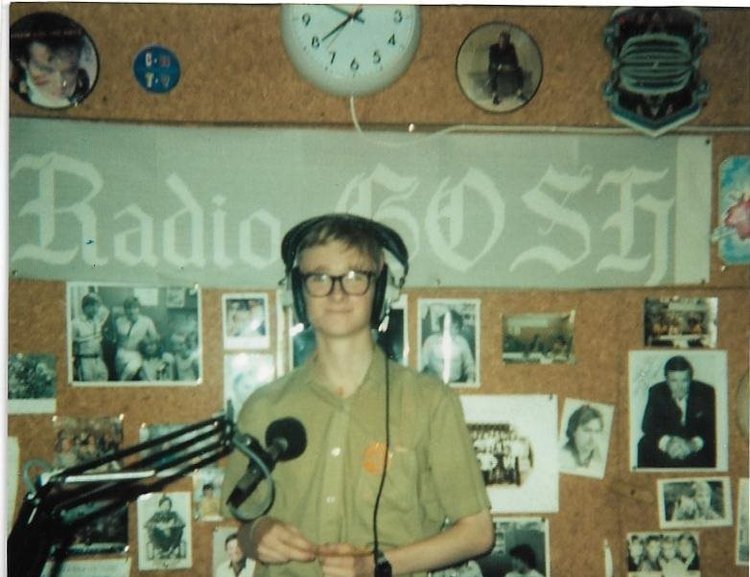Former GOSH patient in Rankin exhibition celebrating the NHS
31 May 2023, 9:14 a.m.
Paul Spencer was eight years old when he underwent life-saving heart surgery at GOSH. Now 56, Paul has had his portrait taken by world-famous photographer Rankin, which will feature alongside those of NHS staff, patients and volunteers in an exhibition celebrating the 75th anniversary of the NHS.
The exhibition, Love and Charity: A History of Giving in the NHS, celebrates the vital role charities, including GOSH Charity, have played throughout the health service’s history and how their contribution has helped make the NHS what it is today.
Paul, a church minister and sound technician from Leeds, features in the exhibition alongside high-profile supporters of the NHS including actor Michael Palin and footballer Jordan Henderson.

Paul's portrait is on display at the Saatchi Gallery. Copyright Rankin.
Paul's story
Paul was born with a heart condition called truncus arteriosus – whereby there is only one large artery leaving the heart instead of two. This means that too much blood goes to the lungs and too little oxygenated blood reaches the rest of the body, leading to difficulties with breathing.
After his initial diagnosis in 1967, when he was just a few months old, Paul’s local hospital referred him to GOSH. At the time, clinicians could only offer a palliative operation that would help relieve the symptoms of the condition for as long as possible.
Innovative surgery
Eight years later a GOSH surgeon introduced a new operation called the Rastelli procedure, that was developed by international colleagues. This meant Paul’s condition could now be treated.
Paul is thought to have been one of the first in the UK to have this operation, when he was just eight years old. At the same time as the Rastelli procedure, surgeons also closed a hole in Paul’s heart.
The operation on Paul’s heart was a success, and his care at GOSH continued until he was 17 years old. During this time, he had further treatment at GOSH, including valve replacement surgery.

Paul presenting on 'Radio GOSH' after his valve replacement surgery when he was 17 years old.
“Charitable work has given me my career as well as my life.”
Paul said, “I’m so proud to be a part of the NHS’s story and am grateful for the incredible care I received at Great Ormond Street Hospital. Thanks to this, I’m now thought to be one of the eldest survivors of truncus arteriosus in the UK.
“When I was 17 and about to have my second major operation at GOSH, I felt the enormity of what was about to happen. It felt like a second chance at life, and a chance for me to do my bit in the world.
“In my role as a Church Minister, I now support people in the UK as well as overseas. Charitable work has given me my career as well as my life.”
Paul now has treatment at Barts Hospital in north London. His consultants also work at GOSH and care for children and young people with congenital heart conditions, like Paul’s.
Paul added, “It was a surprise to be chosen by GOSH to represent them, amongst some big names.
“I’ve not been involved in anything as public as this before. However, I feel it is important to show our pride in our universal health system, and the support its charities give.
“It has been fun.”
Caring for children with rare cardiac conditions today
GOSH is a specialist centre for many heart conditions children are born with, which are known as congenital cardiac conditions. The Hospital’s Cardiology team receives referrals from across the UK and the world.
Emma Carter, Senior Chief Cardiac Physiologist – Specialty Lead at GOSH said, “In the space of 50 years we have gone from offering palliative care for truncus arteriosus to being able to diagnose the condition in foetal life and operate within months of being born.
“The earlier the diagnosis, the sooner we can start providing the best possible care for children with rare heart conditions.”
GOSH Charity has played an important role in providing funding for cardiovascular care at GOSH. For example, we awarded £2.9million to urgently upgrade the Hospital’s cardiac catheter laboratory, which helps GOSH specialists treat more children with heart conditions through a tiny 2mm incision rather than open surgery.
Guided by imaging, clinicians feed narrow tubes and wires through a tiny two-millimetre incision in the skin and into patient’s blood vessels to find the cause of their symptoms, or even to treat the condition itself, without the need for open heart surgery. Procedures like these may mean less pain, a quicker recovery, and less time in hospital for each child.
Visiting the new Rankin exhibition
Love and Charity: A History of Giving in the NHS has been led by NHS Charities Together in collaboration with Rankin Creative. It will be exhibited at the Saatchi Gallery, London between 31 May – 11 June.
Find out more about visiting via the Saatchi Gallery website.






